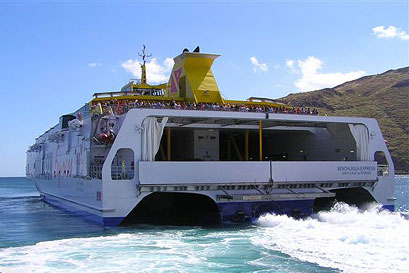Re: Ideal chinese carrier thread
I think that's misleading. Ships of equal displacement will have virtually identical below-waterline volumes. A multi-hull will generally have more above-waterline volume per given displacement.
So, in general terms, a 30,000 tons displacement carrier can easily have a larger hanger than a 60,000 ton monohull carrier. This is why many modern ferries are multi-hulls. The one that comes to mind is:


Where multi-hulls have a trade-off is in the limited weight that can be stored in the relatively spacious upper structure. Fortunately hangers are mostly air, which is free.
Going back to what Popeye and others have pointed out, the true compromise is in heavy stores/munitions/fuel because these are normally stored near/below waterline. All other things being equal, the 30,000 ton multi-hull carrier can only carry about 50-70% the amount of these items as the equivalent 60,000 ton monohull carrier. You could get a bit more by mounting the engines higher (I'd rather not, prefer a larger hanger deck) or using lighter materials.
I'd advocate alloys and composites for many internal 'non-structural' elements and parts of the hull above waterline. The usual cries are about fire issues but these are hotly disputed and alloys are receiving a revival. Much of the anti-aluminum rants are actually off the mark, for example HMS Sheffield in 1982.
The deck would not be armoured. Controversial but realistic.
I think that's misleading. Ships of equal displacement will have virtually identical below-waterline volumes. A multi-hull will generally have more above-waterline volume per given displacement.
So, in general terms, a 30,000 tons displacement carrier can easily have a larger hanger than a 60,000 ton monohull carrier. This is why many modern ferries are multi-hulls. The one that comes to mind is:


Where multi-hulls have a trade-off is in the limited weight that can be stored in the relatively spacious upper structure. Fortunately hangers are mostly air, which is free.
Going back to what Popeye and others have pointed out, the true compromise is in heavy stores/munitions/fuel because these are normally stored near/below waterline. All other things being equal, the 30,000 ton multi-hull carrier can only carry about 50-70% the amount of these items as the equivalent 60,000 ton monohull carrier. You could get a bit more by mounting the engines higher (I'd rather not, prefer a larger hanger deck) or using lighter materials.
I'd advocate alloys and composites for many internal 'non-structural' elements and parts of the hull above waterline. The usual cries are about fire issues but these are hotly disputed and alloys are receiving a revival. Much of the anti-aluminum rants are actually off the mark, for example HMS Sheffield in 1982.
The deck would not be armoured. Controversial but realistic.









